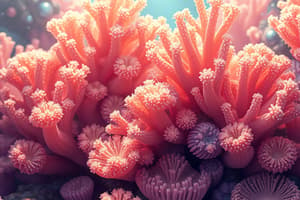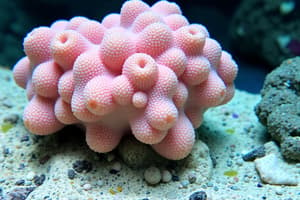Podcast
Questions and Answers
What is the primary mode of digestion in sponges?
What is the primary mode of digestion in sponges?
- Fermentative digestion
- Extracellular digestion
- Chemosymbiotic digestion
- Intracellular digestion (correct)
What term describes the reproductive condition where sponges can produce both eggs and sperm?
What term describes the reproductive condition where sponges can produce both eggs and sperm?
- Oligoecious
- Hermaphrodite (correct)
- Asexual
- Dioecious
What structure in sponges allows water to exit after passing through the spongocoel?
What structure in sponges allows water to exit after passing through the spongocoel?
- Osculum (correct)
- Atrium
- Chamber
- Ostium
What is the purpose of the canal system in sponges?
What is the purpose of the canal system in sponges?
What type of body symmetry is typical of sponges?
What type of body symmetry is typical of sponges?
How do sponges primarily reproduce asexually?
How do sponges primarily reproduce asexually?
Flashcards
Intracellular digestion
Intracellular digestion
The process where food is digested inside the cells of a sponge.
Hermaphrodite
Hermaphrodite
A sponge capable of producing both eggs and sperm.
Osculum
Osculum
The opening at the top of a sponge where water exits after passing through the spongocoel.
Canal system
Canal system
Signup and view all the flashcards
Asymmetry
Asymmetry
Signup and view all the flashcards
Fragmentation
Fragmentation
Signup and view all the flashcards
Study Notes
Phylum Porifera (Sponges)
- Members are commonly known as sponges, primarily marine and mostly exhibit asymmetry.
- Represent primitive multicellular organisms with a cellular level of organization.
- Possess a unique water transport or canal system for essential physiological functions.
- Water enters through minute pores called ostia into the central cavity known as spongocoel.
- Spongocoel connects to the outside environment via osculum, facilitating water flow.
- The water transport system aids in food gathering, respiratory exchange, and waste removal.
- Lined by choanocytes (collar cells) that are crucial for filtering food particles and maintaining water flow.
- Digestion occurs intracellularly within the cells rather than in a digestive cavity.
- The body structure is supported by a skeleton composed of either spicules or spongin fibers.
- Sponges are hermaphroditic; they produce both eggs and sperm from the same individual.
- Reproduction occurs through both asexual (fragmentation) and sexual methods (gamete formation).
- Fertilization is internal, leading to an indirect development process with distinct larval stages.
- Notable examples include Sycon (Scypha), Spongilla (freshwater sponge), and Euspongia (bath sponge).
Studying That Suits You
Use AI to generate personalized quizzes and flashcards to suit your learning preferences.




